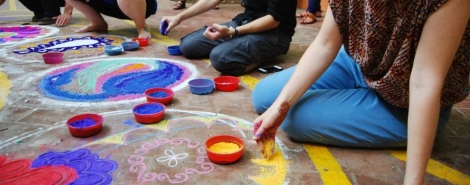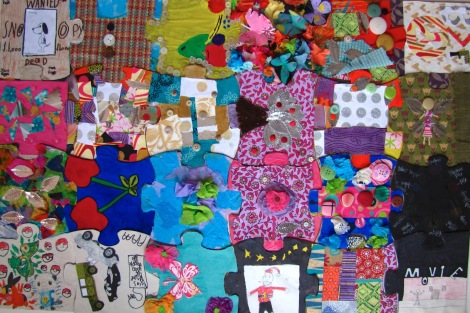by Reiko Fujisawa
Creating art, in general, is considered a solitary activity. Although it can also be made in a group such as in a class, in a community setting, in an institutional setting, etc., even in those groups, people usually make art individually. The difference is that in a group setting, participants can interact, stimulate, and support each other while making art. Their artwork can be influenced by the group dynamics, which can have a greater impact on each participant’s psyche when a group makes one project together.
When participants make a project together, they can develop and improve cooperation skills, cohesiveness, empathy, encouragement, and support for one another. Those feelings lead them towards a sense of community among the other participants, while also bringing them a sense of accomplishment on a larger scale than when they make art individually. Their sense of pride for their artwork boosts their self-esteem. This type of experience builds bridges between the participants and makes the bond lasts longer.
Purpose of making art in a group setting
• To develop the ability to recognize the feelings of other participants.
• To support others’ feelings and thoughts and develop empathy.
• To respect the differences among participants and accept them.
• To explore others’ perspectives.
• To respect personal space and learn appropriate personal boundaries through art making
together.
• To improve communication skills through the process of creating art.
• To discuss a common theme and develop ideas together.
• To cultivate trust among each other.
• To discover leadership skills in each other.
• To create a sense of community.
• To boost self-esteem as a group.
Method
This type of group project is usually made in two 60-90 minutes sessions. The first session would involve discussion around a specific theme and an individual art activity. The second part would be the building phase of the group project, asking the participants to create something together.
At the beginning of the group project, its facilitator would provide a common theme to a group, which would be the foundation of the group art project. The theme would be given by considering the level of the group cognitive function. Participants would then discuss what the theme means to them, including what images/objects they want to have in the project in order to make it coincide with the theme. Then each participant would individually make a small part of the group project. This solitary activity would provide a personal space for each participant and bring a sense of safety and freedom.
After each participant completes his/her personal work, they would build a group project by combining each participant’s work. The action of adding an individual’s piece of work to the group project could bring the participants a feeling of being part of a community. The pieces are visible, and they convey a message to each participant: “You are visible and important in your community.”
This individual work can be very helpful for those who are shy and hesitant to join group work in general. They often have difficulty finding their own space/ task in a group. They might just observe the whole process of art making. Even with much encouragement from the group facilitator, they could have difficulty engaging in tasks with others. On the other hand, those who can be dominant would inevitably respect others’ spaces and appreciate their presence.
The activity of building the group work requires leadership skills, communication skills, consideration of personal space, and a sense of harmony. If the level of group cognitive functioning is not high, the facilitator would lead the group project and guide the participant to where they want to go. If there is a considerably high functioning leader in the group, the facilitator would provide indirect guidance and support throughout the process of making the project.
During the second part of the activity (the building phase), disagreement, lack of understanding and support for participants with needs, as well as a loss of direction can occur. It is here that the facilitator can intervene and try to bring their attention and interests into cohesion. This intervention would repeat as necessary until the end of the process of art making. After the participants complete their work, they can display the project and become audiences of their labor. The facilitator would encourage them to talk about their experiences and feelings. This post-work discussion would bring a deeper understanding of the group members and allow them to bond with each other more. The participants would be proud of their work and foster a sense of self-esteem.
The art project can be drawing, painting, or sculpting. The project can be made with any material. It depends on the needs of the group. More importantly, the two parts of the art making process are essential in this work. In this group work, each individual would receive space, respect and support. This can improve the participant’s sense of self-worth. That said, working together to create one art project can cultivate a greater trust, share creative pleasure, and make the group bond stronger. It can help those who usually cant/don’t want to participate in anything with others. This group experience can transfer to participants’ daily lives and they can feel more confident working in group.
Reiko Fujisawa is a Licensed Creative Arts Therapist in NY and a board certified art therapist.




